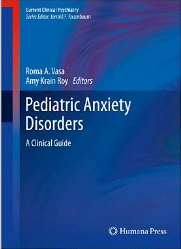“Pediatric Anxiety Disorders: A Clinical Guide”

“Pediatric Anxiety Disorders: A Clinical Guide”
Edited by Roma A. Vasa and Amy Krain Roy
Springer Science+Business Media
New York, N.Y. 2013
Book achieves stated objectives
Reviewed by James K. Luiselli, Ed.D., ABPP, BCBA-D
Having the words “a clinical guide” in a book’s title elicits certain expectations from the reader. The editors of this book aim “to bridge the most up-to-date research findings with relevant clinical perspectives making it a unique and essential resource to established clinicians and researchers, as well as students and trainees.” Thus, the book seeks a wide audience among whom “clinical” is likely to have different meanings and applications.
Part I of the book includes chapters about neurobiology and temperament. These topics are critically important for understanding the etiology of pediatric anxiety disorders, particularly the neurobiological mechanisms that account for fear learning and regulation. There is some dense material here on neuroimaging, brain-behavior correlates and attachment theory, but all of it reasonably presented and explained.
For most clinicians, the strong appeal of the book begins with Part II, a review of eight diagnostic categories: generalized anxiety disorder, social phobia, specific phobia, separation anxiety disorder, panic disorder, obsessive compulsive disorder, posttraumatic stress disorder and selective mutism.
Each chapter begins with a case scenario describing a child or adolescent who presents with the respective disorder. The authors then describe clinical manifestation of the disorder, report prevalence statistics, advise about differential diagnosis, examine etiology and present assessment and treatment strategies. This standard format is a nice touch that facilitates movement among the chapters.
Part III of the book also concerns assessment and treatment but with a broader orientation. For example, one chapter addresses assessment of pediatric anxiety disorders from categorical and dimensional perspectives, providing facts about many standardized instruments and their psychometric properties. Another chapter thoroughly examines conventional components of cognitive-behavioral treatment as well as alternative implementation formats. The psychopharmacology and pharmacotherapy of anxiety disorders is contained in a separate chapter.
In the last part of the book, the editors have two “special topics” chapters, one of them dealing with anxiety in children who have medical conditions such as asthma, headache, inflammatory bowel disease and cancer. The second chapter has to do with anxiety in children with autism spectrum disorder, a rapidly emerging area of practice and research. The information found in these chapters, like others in the book, is timely and evidence-supported.
Editors Roma A. Vasa and Amy Krain Roy should be commended for assembling highly recognized and respected experts in pediatric anxiety disorders. Note, however, that the book predated publication of DSM-5, although most of the chapter authors entertain what the then proposed diagnostic revisions will entail for clinicians. This suggests to me that a second edition of the book may be a worthy enterprise in the future.
I recommend this book as one of the best contemporary resources for understanding, assessing, and treating pediatric anxiety disorders. I would not qualify the book as a guide per se but certainly it achieves the stated clinical and research objectives. The extensive references section in each chapter also gives readers ample publication citations to pursue further inquiry.
James K. Luiselli, Ed.D., ABPP, BCBA-D, is senior vice president, applied research, clinical training and peer review at the May Institute in Norwood, Mass.
Learn more about the book: Pediatric Anxiety Disorders: A Clinical Guide (Current Clinical Psychiatry)
